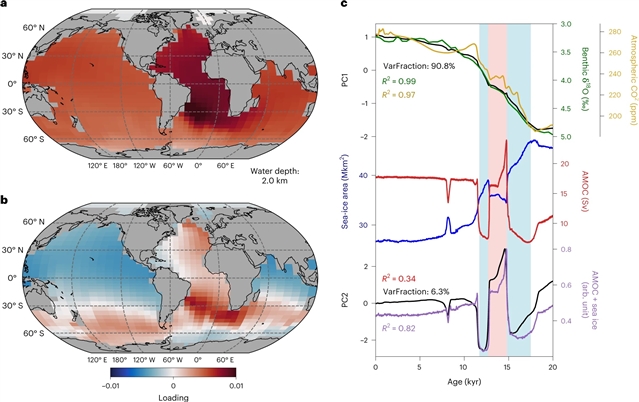
瑞士伯尔尼大学 Poppelmeier Frerk的研究小组报道了自上一个冰期以来,多代理限制的大西洋循环动力学。2023年4月3日出版的《自然—地球科学》杂志发表了这项成果。
研究人员利用来自跟踪环流各个方面的代理记录汇编和气候模型模拟的信息,来限制过去两万年的大西洋环流。研究发现,在上一个的冰川的最大值期间,一个连贯的,浅而弱的大西洋翻转环流,调和了明显矛盾的代理证据。最近一次冰川消退的模型数据比较(从新的、多重约束的冰川状态开始)表明其在海因里希-冰期事件1期间反应较弱,水团几何形状没有完全适应相对较短的新仙女木事件期间翻转环流的强还原。研究强调,淡水作用力和大西洋倾覆强度之间的关系强烈依赖于气候和海洋背景状态。
据介绍,人们在理解大西洋经向翻转环流及其对淡水或辐射增强等外部扰动的反应方面,仍然存在不确定性。大西洋环流的突然减少被认为是一个气候转折点,当地球气候被推离上一个冰河时代时,这个转折点可能已经过去了。然而,由于受到模型和代表权的限制,自上一个冰川的最大值(2.2到1.8万年前)期以来,环流的演变仍然没有得到充分的约束。
附:英文原文
Title: Multi-proxy constraints on Atlantic circulation dynamics since the last ice age
Author: Poppelmeier, Frerk, Jeltsch-Thmmes, Aurich, Lippold, Jrg, Joos, Fortunat, Stocker, Thomas F.
Issue&Volume: 2023-04-03
Abstract: Uncertainties persist in the understanding of the Atlantic meridional overturning circulation and its response to external perturbations such as freshwater or radiative forcing. Abrupt reduction of the Atlantic circulation is considered a climate tipping point that may have been crossed when Earth’s climate was propelled out of the last ice age. However, the evolution of the circulation since the Last Glacial Maximum (22–18 thousand years ago) remains insufficiently constrained due to model and proxy limitations. Here we leverage information from both a compilation of proxy records that track various aspects of the circulation and climate model simulations to constrain the Atlantic circulation over the past 20,000 years. We find a coherent picture of a shallow and weak Atlantic overturning circulation during the Last Glacial Maximum that reconciles apparently conflicting proxy evidence. Model–data comparison of the last deglaciation—starting from this new, multiple constrained glacial state—indicates a muted response during Heinrich Stadial 1 and that water mass geometry did not fully adjust to the strong reduction in overturning circulation during the comparably short Younger Dryas period. This demonstrates that the relationship between freshwater forcing and Atlantic overturning strength is strongly dependent on the climatic and oceanic background state.
DOI: 10.1038/s41561-023-01140-3
Source: https://www.nature.com/articles/s41561-023-01140-3
